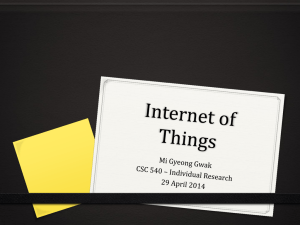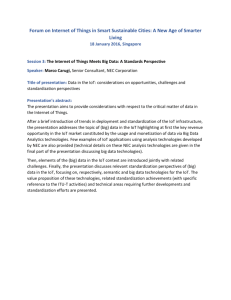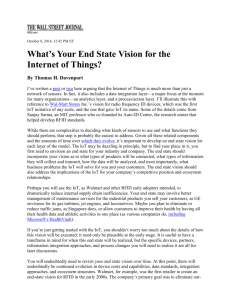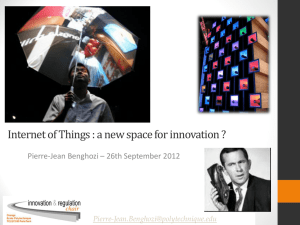IoT Paper Rough Draft - University of San Diego Home Pages
advertisement
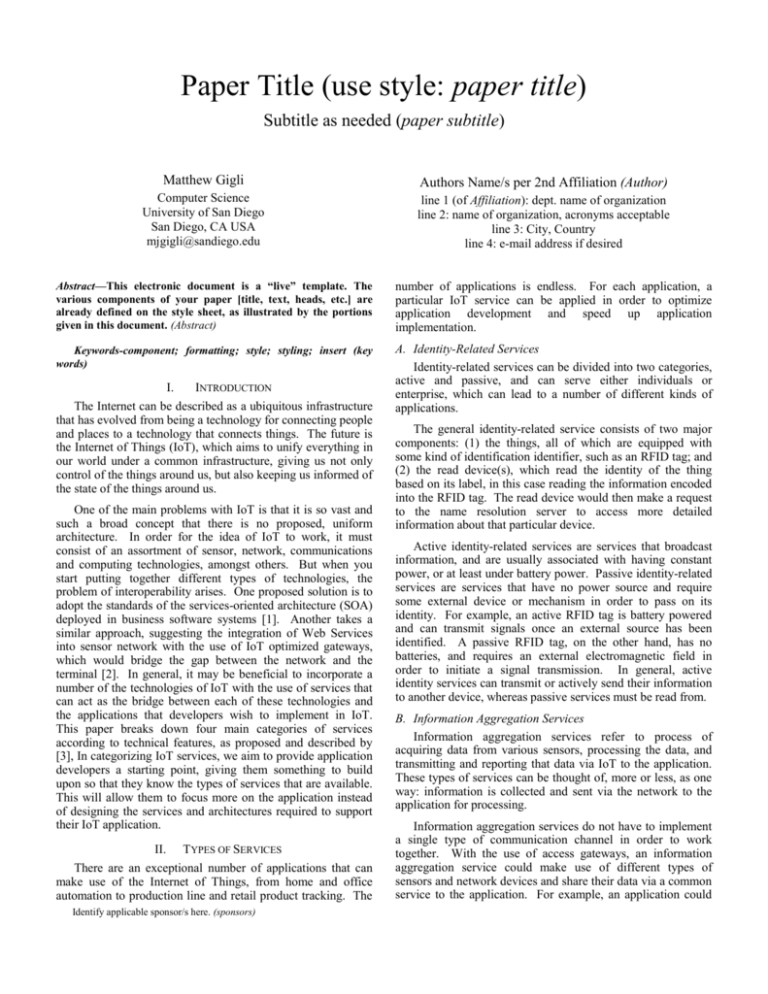
Paper Title (use style: paper title) Subtitle as needed (paper subtitle) Matthew Gigli Authors Name/s per 2nd Affiliation (Author) Computer Science University of San Diego San Diego, CA USA mjgigli@sandiego.edu line 1 (of Affiliation): dept. name of organization line 2: name of organization, acronyms acceptable line 3: City, Country line 4: e-mail address if desired Abstract—This electronic document is a “live” template. The various components of your paper [title, text, heads, etc.] are already defined on the style sheet, as illustrated by the portions given in this document. (Abstract) number of applications is endless. For each application, a particular IoT service can be applied in order to optimize application development and speed up application implementation. Keywords-component; formatting; style; styling; insert (key words) A. Identity-Related Services Identity-related services can be divided into two categories, active and passive, and can serve either individuals or enterprise, which can lead to a number of different kinds of applications. I. INTRODUCTION The Internet can be described as a ubiquitous infrastructure that has evolved from being a technology for connecting people and places to a technology that connects things. The future is the Internet of Things (IoT), which aims to unify everything in our world under a common infrastructure, giving us not only control of the things around us, but also keeping us informed of the state of the things around us. One of the main problems with IoT is that it is so vast and such a broad concept that there is no proposed, uniform architecture. In order for the idea of IoT to work, it must consist of an assortment of sensor, network, communications and computing technologies, amongst others. But when you start putting together different types of technologies, the problem of interoperability arises. One proposed solution is to adopt the standards of the services-oriented architecture (SOA) deployed in business software systems [1]. Another takes a similar approach, suggesting the integration of Web Services into sensor network with the use of IoT optimized gateways, which would bridge the gap between the network and the terminal [2]. In general, it may be beneficial to incorporate a number of the technologies of IoT with the use of services that can act as the bridge between each of these technologies and the applications that developers wish to implement in IoT. This paper breaks down four main categories of services according to technical features, as proposed and described by [3], In categorizing IoT services, we aim to provide application developers a starting point, giving them something to build upon so that they know the types of services that are available. This will allow them to focus more on the application instead of designing the services and architectures required to support their IoT application. II. TYPES OF SERVICES There are an exceptional number of applications that can make use of the Internet of Things, from home and office automation to production line and retail product tracking. The Identify applicable sponsor/s here. (sponsors) The general identity-related service consists of two major components: (1) the things, all of which are equipped with some kind of identification identifier, such as an RFID tag; and (2) the read device(s), which read the identity of the thing based on its label, in this case reading the information encoded into the RFID tag. The read device would then make a request to the name resolution server to access more detailed information about that particular device. Active identity-related services are services that broadcast information, and are usually associated with having constant power, or at least under battery power. Passive identity-related services are services that have no power source and require some external device or mechanism in order to pass on its identity. For example, an active RFID tag is battery powered and can transmit signals once an external source has been identified. A passive RFID tag, on the other hand, has no batteries, and requires an external electromagnetic field in order to initiate a signal transmission. In general, active identity services can transmit or actively send their information to another device, whereas passive services must be read from. B. Information Aggregation Services Information aggregation services refer to process of acquiring data from various sensors, processing the data, and transmitting and reporting that data via IoT to the application. These types of services can be thought of, more or less, as one way: information is collected and sent via the network to the application for processing. Information aggregation services do not have to implement a single type of communication channel in order to work together. With the use of access gateways, an information aggregation service could make use of different types of sensors and network devices and share their data via a common service to the application. For example, an application could make use of RFID tags to be aware of the identity of some devices, while also using a ZigBee network to collect data from sensors, then use a gateway device to relay this information to the application under the same service, say a Web Service such as JSON or XML. Not only would this allow a developer of an application to incorporate a number of different technologies into the application, but it could also allow the application to access various IT and enterprise services that may already be in place. Block diagram showing sensor network, gateway, processing, delivery to application for further processing and recording through the use of an “aggregation layer”. Talk about different technologies (NFC, ZigBee, WSNs, etc) and how they can be connected with a service? C. Collaborative-Aware Services Collaborative aware services are services that use aggregated data to make decisions, and based on those decisions perform an action. As IoT takes shape, it should bring about the development of complicated services that make use of all of the data that can be retrieved from the extensive network of sensors. This will require not only being able to retrieve information, but to relay back responses to the collected information to perform actions. These services will thus require “terminal-to-terminal” as well as “terminal-toperson” communication. By providing collaborative aware services, the IoT infrastructure naturally requires greater reliability and speed, and will require the terminals to either have more processing power or be linked with some other device that does. Include block diagram showing the use of acquired sensor data to perform collaborative aware actions. D. Ubiquitous Services Ubiquitous services are the epitome of the Internet of Things. A ubiquitous service would not only be a collaborative aware service, but it would be a collaborative aware service for everyone, everything, at all times. In order for IoT to reach the level of providing ubiquitous services, it would have to overcome the barrier of protocol distinctions amongst technologies and unify every aspect of the network. There is no particular system architecture for the Internet of Things, but there have been numerous papers written about the use of Web Services or REST (representational state transfer) APIs (application programming interfaces) to unite loosely coupled things on the Internet under a single application so that they can be reused and shared. [4] proposes such an architecture, which if implemented would be considered a ubiquitous service. Include block diagram of ubiquitous service, showing how everything can be accessed by everyone, everywhere. Include current research on ubiquitous services. III. APPLICATIONS OF IOT SERVICES In this section, go through each of the above mentioned services again, this time giving examples of various types of applications that either use, or could use, the above mention services to implement their application. Try to find common themes in technology use so as to provide a basis for each of the service types, thus laying down a framework to build an application upon a specific type of service. A. Identity-Related Services Identity-related services are the most simple, yet maybe one of the most important, services to be provided to an application of the Internet of Things. Applying an identity-related service to an application provides the developer with vital information about every device, or every thing, in their application. The most prominent technology used in identity-related services is RFID. RFID is a technology that enables data to be transmitted by a tiny portable device, called a tag, which is read by an RFID reader and is processed according to the needs of that particular application. RFID provides an upgrade from the traditional form of device identification: barcode scanning. RFID is more versatile because it does not require line of sight transmission, and, in the case of active RFID tags, can transmit its data as opposed to simply just being read by a reader device. Most IoT applications that are aimed at providing an identity-related service make use of RFID technology. As described in [5], the RFID tag stores an identification code unique to that device. The RFID reader reads that code, and looks up the device in the RFID server, which then returns the detail information require by the application. Production and shipping are two common applications that would benefit greatly from the use of an identity service. In production, you may want to monitor the life cycle of the products being produced [6]. Another application that uses an identity-related service describes a model that can solve the information asymmetry problem in supply chain management and supply chain information transmission [7]. Every IoT application will either be based on, or at least incorporate some instance of, an identity-related service. This is because for the IoT to incorporate everything in the physical world to the digital world, the application will need to be able to identify all of the devices that are connected. B. Information Aggregation Services Information aggregation services incorporate identity related services, along with other components such as WSNs, and access gateways to collect information and forward it to the application for processing. The information aggregation service is just responsible for providing the application with all of the information that is collected, and potentially processed along the way, from the terminals of the system (sensors, RFID tags, etc). In this regard, the WSN can be a powerful tool for collecting and communicating data between terminals and the platform (host of application), as long as the platform is within range of the WSN. But this would not be an IoT application on its own; an IoT application would consist of multiple WSNs all configured to work together to provide information about the world around them. The link between these networks is an access gateway. There are a number of applications out there that make use of information aggregation services and access gateways. In [8], the importance of extending the information aggregation service to beyond the WSN is proposed by using a cellular network (CN) to extend the range of the WSN. The idea is that if a terminal is outside of the WSN of interest, it uses CN resources to access that information through the use of an “IoT gateway,” which essentially implements both WSN and CN resources. Unless there are six authors or more give all authors' names; do not use “et al.”. Papers that have not been published, even if they have been submitted for publication, should be cited as “unpublished” [4]. Papers that have been accepted for publication should be cited as “in press” [5]. Capitalize only the first word in a paper title, except for proper nouns and element symbols. Information aggregation services are useful in monitoring situations, such as energy monitoring in the house and in the enterprise, or, if the Internet of Things has been realized, monitoring of anything, anywhere. For example, [9] introduces a monitoring and control system for use in an agriculture greenhouse production environment. The system measures and records critical temperature, humidity and soil signals which is then transmitted through the network to the platform for processing. Another application [10] uses a ZigBee WSN to monitor physiological data of patients that automatically generates electronic medical records. For papers published in translation journals, please give the English citation first, followed by the original foreign-language citation [6]. C. Collaborative-Aware Services D. Ubiquitous Services IV. CONCLUSION Conclude. ACKNOWLEDGMENT The preferred spelling of the word “acknowledgment” in America is without an “e” after the “g”. Avoid the stilted expression, “One of us (R. B. G.) thanks . . .” Instead, try “R. B. G. thanks”. Put sponsor acknowledgments in the unnumbered footnote on the first page. REFERENCES The template will number citations consecutively within brackets [1]. The sentence punctuation follows the bracket [2]. Refer simply to the reference number, as in [3]—do not use “Ref. [3]” or “reference [3]” except at the beginning of a sentence: “Reference [3] was the first . . .” Number footnotes separately in superscripts. Place the actual footnote at the bottom of the column in which it was cited. Do not put footnotes in the reference list. Use letters for table footnotes. [1] P. Spiess, S. Karnouskos, D. Guinard, D. Savio, O. Baecker, L. Moreira Sa de Souza, and V. Trifa, “SOA-based Integration of the Internet of Things in Enterprise Services,” Proceedings of the 2009 IEEE International Conference on Web Services (ICWS '09). IEEE Computer Society, Washington, DC, USA, 968-975. [2] T. Ridel, N. Fantana, A. Genaid, D. Yordanov, H. R. Schmidtke, and M. Biegl, “Using Web Service Gateways and Code Generation for Sustainable IoT System Development,” Internet of Things (IoT), 2010, vol., no., pp.1-8, Nov. 29 2010-Dec. 1 2010. [3] Xing Xiaojiang, Wang Jianli, Li Mingdong, “Services and Key Technologies of the Internet of Things,” ZTE Communications, No.2, 2010. [4] D. Guinard, “Towards opportunistic applications in a Web of Things,” 2010 8th IEEE International Conference Pervasive Computing and Communications Workshops (PERCOM Workshops), vol., no., pp.863864, March 29 2010-April 2 2010. [5] Jia Gao, Fangli Liu, Huansheng Ning, Baofa Wang, “RFID Coding, Name and Information Service for Internet of Things,” IET Conference on Wireless, Mobile and Sensor Networks, 2007, vol., no., pp.36-39, 1214 Dec. 2007. [6] R. Nicole, “Title of paper with only first word capitalized,” J. Name Stand. Abbrev., in press. [7] Bo Yan, Guangwen Huang, “Supply chain information transmission based on RFID and internet of things,” ISECS International Colloquium on Computing, Communication, Control and Management, 2009, vol., no., pp.166-169, 8-9 Aug. 2009. [8] Jia Shen, Xiangyou Lu, Huafei Li, Fei Xu, “Hetereogeneous multi-layer access and RAM for the internet of things,” 2010 5 th International ICST Conference on Communications and Networking in China (CHINACOM), vol., no., pp.25-27 Aug. 2010. [9] Ji-chun Zhao, Jun-feng Zhang, Yu Feng, Jian-xin Guo, “The study and application of the IOT technology in agriculture,” 2010 3rd IEEE International Conference on Computer Science and Information Technology (ICCSIT), vol.2, no., pp.462-465, 9-11 July 2010. [10] Jingran Luo, Yulu Chen, Kai Tang, Junwen Luo, “Remote monitoring information system and its applications based on the Internet of Things,” International Conference on Future BioMedical Information Engineering (FBIE), 2009, vol., no., pp482-485, 13-14 Dec. 2009. [11]




